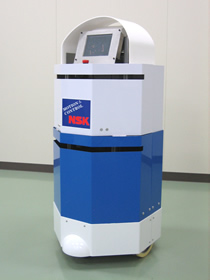Tokyo, Japan, November 25, 2009 – NSK Ltd. (NSK; Headquarters: Tokyo, Japan; President & CEO: Norio Otsuka) today announced the development of a robot able to assist people with mobility challenges, guiding them along a path of their choice while avoiding obstacles.
Global
ASEAN and Oceania
Middle East
Africa
Press Release
December 4, 2009
NSK Ltd.
CSR Division Headquarters
Public Relations Department
NSK Develops Human-Assisting Guidance Robot
Robot offers hope to people with mobility challenges

A wheeled robot newly developed by NSK can help mobility challenged users travel over flat surfaces, inclines and slightly uneven surfaces. Interpreting human intentions via subtle changes in force applied to hand grips that support the user, the robot autonomously selects and follows an obstacle-free path.
Integrating innovations in drive technology, visual-recognition technology and interface technology, this experimental robotic aid to human mobility points the way to future alternatives to wheelchairs, seeing-eye dogs and nursing assistants. It was on display at the International Robot Exhibition 2009, held at Tokyo
Big Site from November 25 to 28.
Product features
- Finding and following an obstacle-free path
- To guide the user along a clear path, the robot uses laser range sensors to detect obstacles. As obstacles are detected, the robot calculates the “virtual repulsive force*1” according to their distance and direction. Command values from the user are then automatically modified according to the anticipated effect of that repulsive force.
*1 Repulsive force: The force by which objects repel one another.
- Smooth, intuitive operation
- The robot interprets the user's intended direction and speed through pressure exerted on the hand grips in an intuitive way: push harder to go faster; push right to turn right. Processing is performed to eliminate any adverse effect caused by differences in the movement of user and robot as force is applied. This allows the robot to understand instructions precisely and respond smoothly.
- Mobility over inclines and uneven surfaces
- With independent two-wheel drive and an active caster mechanism, the robot can handle inclines and uneven surfaces.
Background to development
With many countries now facing the implications of a rapidly aging society, the challenge is to find new solutions that enable people to live not only longer but better. Having developed rapidly in recent years through cross-fertilization with other fields (such as IT), robotic technology is now poised to make a significant contribution.
Until now, NSK's involvement in robotics has focused on the supply of components such as bearings, linear guides and ball screws. So the introduction of a new human-assisting robot marks an important step forward. By exploring the uses of its core products to their fullest extent, NSK hopes to make an important contribution toward meeting a critical social need, and to advance its knowledge of core robotics technologies.
NSK will continue working to identify underlying issues in this field, engaging its four core technologies – tribology, materials, analysis and mechatronics – to create robotic solutions to real human needs.
